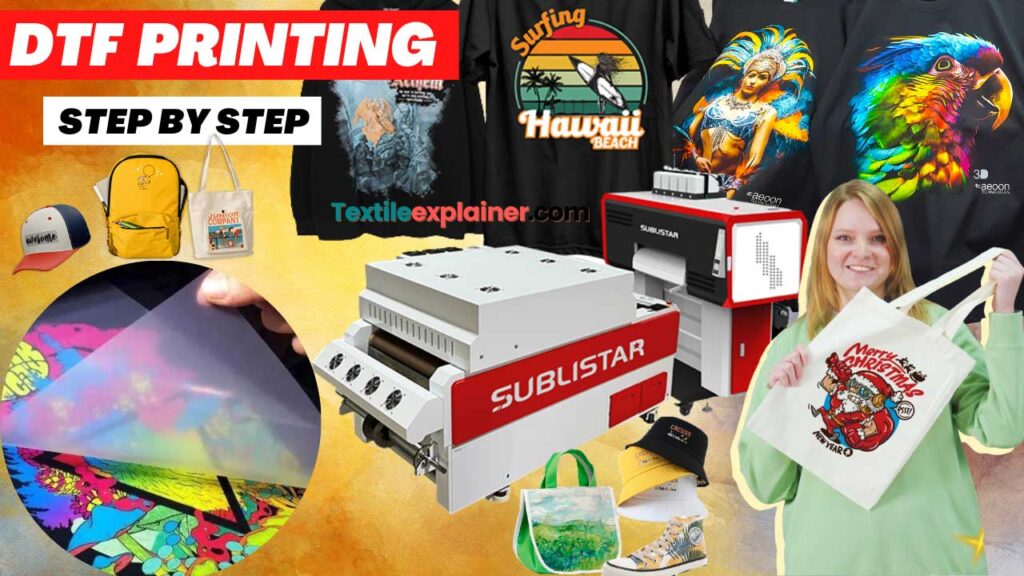A Deep Study DTF Printing: Techniques, Benefits, and Market Applications
A Deep Study DTF Printing: Techniques, Benefits, and Market Applications
Blog Article
Ultimate Guide to DTF Printing Techniques for Sensational Fabric Designs
Beginning on the trip of grasping DTF printing techniques can open up a world of possibilities for producing visually exciting fabric styles. In this guide, we will explore the intricate information of DTF printing, from realizing the essential fundamentals to unraveling progressed color strategies that can boost your styles to new heights.
Understanding DTF Printing Essentials
DTF printing, a procedure that involves moving designs from an unique film to fabrics utilizing warm and stress, creates the foundation of textile printing strategies. This ingenious method enables top quality, vibrant layouts to be perfectly transferred onto numerous materials with precision and information. The first action in DTF printing involves developing or choosing a layout that will certainly be published onto the fabric. This design is after that published onto a special movie utilizing a DTF printer, which makes use of details dyes or pigments to make certain color precision and toughness.
The final result is a spectacular, lasting textile layout that is washable, flexible, and resistant to fading. Overall, understanding the basics of DTF printing is necessary for mastering this modern-day textile printing strategy.
Picking the Right Fabric Materials
Having actually established the fundamental principles of DTF printing methods for textile designs, the following vital factor to consider lies in selecting the proper fabric products to match this cutting-edge process successfully. The success of a DTF print mostly depends upon the compatibility in between the chosen textile and the printing method. When selecting textile products for DTF printing, it is important to think about the material's make-up, weave, and texture. Fabrics that function well with DTF printing consist of polyester blends, spandex, nylon, and other synthetic materials. These materials typically have a smooth surface that permits vivid and comprehensive prints. Furthermore, the stretchability of these products can fit the heat transfer process included in DTF printing without misshaping the design. It is a good idea to prevent natural fibers such as cotton or silk, as they might not generate the same level of print quality and durability. By selecting the appropriate textile materials, developers can maximize the possibility of DTF printing to create lasting and magnificent fabric layouts.

Grasping the Printing Process
To excel in DTF printing techniques for fabric styles, grasping the printing process is essential for accomplishing consistent and premium outcomes. The printing procedure in DTF includes a number of essential steps that need accuracy and attention to detail. To start with, preparing the artwork for printing is critical. This includes making certain the style is appropriately sized and placed for the fabric. Next off, the design is printed onto a special DTF film making use of a suitable printer with the ideal settings to achieve ideal shade vibrancy and quality (DTF Printing). Once the style is printed, it is then moved onto the material making use of a warm press device. The temperature, stress, and duration of heat application must be very carefully managed to guarantee correct attachment of the design to the fabric. Additionally, understanding the peeling off procedure after heat pushing is crucial to stop any type of damage to the design or fabric. By honing each of these action in the printing procedure, designers can continually create spectacular and resilient textile layouts with DTF printing strategies.
Enhancing Styles With Color Techniques

Furthermore, trying out color gradients can bring a sense of movement and fluidness to the layout. By blending shades effortlessly, a gradient impact can be accomplished, adding a dynamic and modern touch to the fabric design. In addition, utilizing shade obstructing strategies can create striking and strong visuals by comparing various strong colors in distinctive areas of the design.
Moreover, incorporating metal or neon colors can supply a special and distinctive element to the fabric design, making it stand apart and emanate a sense of vibrancy. When purposefully applied, these color strategies can elevate the total aesthetic appeal of textile designs, making them a lot more fascinating and remarkable.
Troubleshooting Common DTF Printing Issues
After exploring different shade methods to improve textile styles, it is essential visit to deal with usual DTF printing issues that might arise during the production procedure. In addition, problems with image clearness and sharpness can take place due to low-resolution pictures or inappropriate printing strategies. By being conscious of these common problems and applying the needed troubleshooting actions, you can improve the total top quality of your DTF published textile layouts.
Conclusion
In final thought, understanding DTF printing techniques is important for developing spectacular textile designs. With practice and attention to information, one can create distinct and lovely textile layouts utilizing DTF printing techniques.
Layouts))))
DTF printing, a process that includes transferring designs from an unique film to fabrics using heat and stress, develops the foundation of fabric printing methods.Having established the foundational concepts of DTF printing strategies for fabric designs, the following critical factor to consider lies in choosing the appropriate fabric website here materials to enhance this ingenious process successfully. By selecting the ideal textile materials, developers can maximize the capacity of DTF printing to develop long-lasting and magnificent textile designs.
To stand out in DTF printing methods for textile layouts, Recommended Site mastering the printing process is crucial for accomplishing consistent and top notch results. DTF Printing. By honing each of these steps in the printing procedure, developers can consistently create stunning and long lasting textile layouts with DTF printing methods
Report this page